- Home
- Flights
- Balloon Instructions
/Information - Copyright©
1996-2015 - Special Thanks to the following references:
- Wikipedia.com
- National Geographic 1935-1936
- Kevin Cook, American Heritage 1935
- Kenneth George (deceased)
- Pat Tomovich, Stratobowl Landowner
- Kay West
- Minnilusa Historical Association
- Photos by: Ken Tomovich, Bill Groethe

Stratospheric Balloon History-Stratophere Balloon
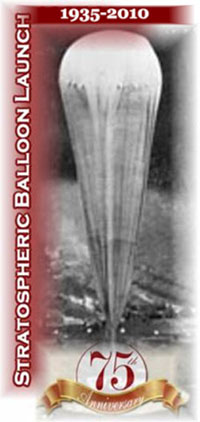

History
Stratospheric Balloon Explorer Mission
From Concept to Flight
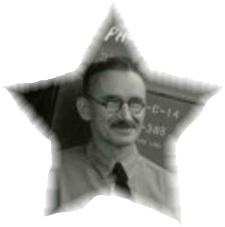
Captain Albert Stevens was a brilliant and innovative photographer who first enlisted in the aviation section of the U.S. Army Signal Corps and later was tranferred to the position of Chief of the Army Air Corps' Photography Laboratory at Wright Field, OH. His creation of the first, large photomosaic map for the Army Air Service and Geological Survey, as well as the first photograph of the Moon's shadow projected onto the Earth proved his intellect and creativity. To procure a photograph of the Earth from high, was probably just a dream at first. However, after Albert Stevens secured funds by both private and public sources, his dream was soon to become a reality.
The first balloon was sponsored and built by Goodyear-Zeppelin Corporation and engineered by, then Vice President, Karl Arnstein. The second and larger balloon was sponsored by The National Geographic Society. Of course, none of this would have been possible without the assistance of the United States Army Air Corp. These balloon envelopes were the largest ever built and amassed 3,000,000 to 3,700,000 cubic feet. The reason behind the enormity of these balloons was they needed to carry a payload of over a ton of scientific instruments, as well as Aeronauts who would fly them to the edge of the Earth's atmosphere...the stratosphere.
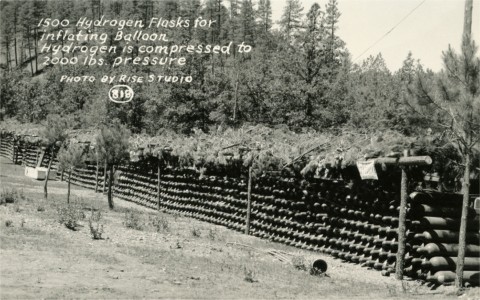
The balloon (bag), gondola, ballast, and instruments weighed 7 1/2 tons at the time of takeoff. The envelope itself weighed over 3 tons and at 72,395 feet would expand to nearly 200 feet in diameter. If the envelope had been filled to capacity at ground level (instead of the less than 7%), it would have liftedHydrogren Flasks (1935) more than 100 tons off out of the Stratobowl at take-off. But, since the balloon needed to expand as it rose, it could only be filled with a small quantity of gas...hydrogen for Explorer, the smaller of the two and helium used for the first time for the larger Explorer II.
On the balloon flight’s 20th Anniversary in 1955, Dr. Hugh L. Dryden, director of NACA, said this historic flight into the stratosphere produced new data on cosmic rays, the chemical composition, electrical conductivity, and living spore content of the air above 70,000 feet, the ozone layer, and radio transmission from high altitudes. More important, he said, was the “convincing demonstration that man could protect himself from the environment of the stratosphere.”
In a speech by Albert Stevens the same year as the success of Explorer II, Stevens is quoted as saying,
"The purpose in flying in the stratosphere is not primarily to get as far away from the earth as one can. It is rather to get up to an elevation where there is little air above you as possible. There is a considerable difference between the two purposes. In other words, we wanted most of all to get to an elevation where radiation from space is coming in without being checked by a great mass of air.
Stratophere flying, for many scientists, is to obtain data on cosmic radiation and on the amount of ozone present at high elevations. Stratosphere flying, from the view point of the Bureau of Standards and the United States Army Air Corps, is for the purpose of getting additional data on the temperature of the air, and the pressure at elevations reached as compared with measurements of the same elevation by means of aerial cameras.
In making the flight it was best not to concentrate on one line of work entirely, and so we decided to take all the apparatus that could be furnished by leading scientific institutions of the United States and to do as many things of scientific interest as possible."
Stevens was also asked about men in space. He then commented on the impossibility of space flight. With the data collected from the Explorer Mission advances in the use of magnesium alloys, pressurization techniques, and personal equipment such as heated flying suits, and many other items of equipment and methods were improved. These later played an important part in giving American airmen superiority in the skies of Berlin and Tokyo, as well as an avenue to the stars and man's first walk on the moon 32 years after it was deemed an "impossibility".
This is the story of the famous and historic flight to space...
Trial Flight - Explorer
July 28, 1934
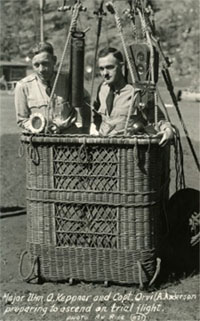
The first trial was set for July 28, 1934. The gondola arrived first by truck from Midland, Michigan in late June followed a few days later by the balloon (envelope or bag). The first balloon was sponsored by the Goodyear Zeppelin and was an experimental 3,000,000 cubic foot balloon. On July 6, a ground crew consisting of troops from Fort Meade performed a practice hydrogen gas inflation at the "Stratobowl" camp. It was a success. At 1:30 PM on July 27, 1934, inflation with hydrogen gas began for a flight the next day. This 3,000,000 cubic foot balloon was inflated to 7.5 percent capacity to allow for the expansion needed in order to have the balloon reach 179 foot sphere at 65,000 feet. Pilot Kepner, photographer Stevens, and Co-pilot Anderson were sealed inside the gondola. On July 28, 1934 the US Army Air Corps produced the first balloon called Explorer which was the largest balloon built (84,950 cubic meters). With Stevens and Anderson inside the gondola and Kepner on top the rope cage to direct takeoff, 80 pounds of lead ballast was removed and the christened "Explorer" started to rise at 5:45 AM.
As Explorer rose rapidly into the skies, and over the rim of the camp at the Stratobowl location, it headed eastward toward Omaha, Nebraska. Thousands of people had gathered for this historic event as the balloonwas inflated throughout the night and waved from the rim to the aeronauts asKenneth George, Explorer Crew they attempted to slow the rate of ascent in order to have the scientific equipment onboard functioning properly. At the base of the stratobowl camp, an apprentice printer from Rapid City, SD by the name of Kenneth George bent down and collected lead pellets as they poured from the metal orb that littered the ground. He carefully placed them in a blue glass jar until they reached the top and encased them with a tin lid. He had been working as a local crew member for the project and had written to his mother of the excitement he felt being a part of history.
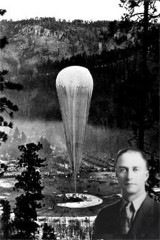
(Authors note: That man was my grandfather. Years after I became a hot air balloon pilot and then taught my father, Robert George, to fly balloons, it was produced from an old family trunk along with a postcard and letters to my Grandmother. This fascinated me to know that I was now a part of history, was a third generation balloonist in a manner of sorts, and led to my interest in flying out of the Stratobowl on the 75th Anniversary. Now, back to our story.)
The first equalibrium was reached at 14,500 feet. At this point, Major Kepner and Captain Anderson crawled inside and joined Captain Stevens after standing by on top the rigging in order to handle the external emergency gas valve. Then Stevens and Kepner crawled outside to lower a 125 pound spectrograph on a 500 foot rope. This was to allow pictures of the stratosphere to be taken from Explorer. At 15,000 radio contact was established with ground control.
As the scientific instruments whirled and clicked, Stevens commented, "the relays sounded like many typewriters in a newspaper office or like a flock of chickens pecking grain from a metal pan." At 10 AM the two manholds were covered and 280 pounds of lead ballast was released. This allowed Explorer to rise to 40,500 feet within an hour's time. At 1:15 PM, the 57,000 foot level was achieved when the crew heard a clattering noise overhead. Looking through the 3" upper port, and witnessed part of the appendix cord, falling on the roof of the gondola. As the crew looked upward, a 30 foot rip and three smaller tears in the lower part of the balloon were visible. As the balloon continued to climb to 60,613 feet (18,475 meters) the three aeronauts valved but the sun's rays expanded the hydrogen until the balloon was able to stop the ascent and begin downward 20 minutes later.
As Kepner readied to release the 80' parachute, the balloon envelope disintegrated. The temperature outside the gondola was 80 degrees below zero Farenheit while the inside temperature was just above freezing and getting colder as Explorer descended. Scientific instruments sounded warnings which enveloped the inside cabin, making it hard to talk between the three aeronauts who still needed to keep their routine of making oxygen, recording data, and deciding when to jump for safety.
In 45 minutes Explorer was down to 40,000', and then 20,000' another 30 minutes later. Both Kepner and Anderson forced open the hatch and scrambled out to take a look at the enormous bag which still held air in the upper section while the lower fabric wrestled to and fro from the wind speed, tearing it further apart. Suddenly the entire bottom of the bag dropped, allowing the top portion to act as a parachute. At this time, Kepner and Anderson cut loose the spectrograph which floated to earth on its own parachute. It was time to "lighten the load" and slow the rate of descent. As Stevens jettisoned the remaining ballast...liquid air and their empty containers were fastened to parachutes and thrown overboard, lead ballast poured through the hopper in streams and through the hatch as each sack was opened individually.
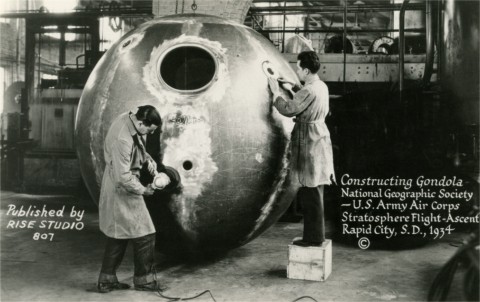
At 10,000' the three still did not want to abandon the ship and continued on until Explorer reached 6,000' when Kepner jumped. Anderson was the second to grab the folds of his silk chute and exit the aircraft. At 5,000' ASL (above sea level) or 2,000 ASL in that part of Nebraska, Stevens was the last inside the gondola. As he prepared to exit, the remaining envelope burst into pieces and Explorer plummeted to earth. Twice Stevens tried to push himself out the the spinning orb, only to have the wind pressure push him into the rapidly falling sphere.
Explorer was now at 3,500' when Stevens was able to propel himself out of the port hole and into space. This may have been a fortunate thing, except now Stevens was falling next to and with the same speed as the gondola. As he pulled his rip cord, the chute expanded only to have a portion of the balloon fabric fall to the center of his canopy and then slide free. Stevens had enough time to look up and see the parachutes of Kepner and Anderson, then hear the tremendous thud of the gondola flattening onto the earth, before he too hit the ground seconds later.
The adventure of the first Explorer proved how important and dangerous the race to the stratosphere was for mortal men. Others who had tried before the success of Explorer II died in the race to become the first to witness the earth's aura from space.
Success at Last - Explorer II
November 11, 1935
On November 11, 1935, Explorer II, the first helium balloon, reached a height of 72,399 (22,066 meters) above sea level or nearly 14 miles from the earth. The the manholes were widened for easier escape, and the balloon was filled with non-flammable helium to avoid the possibility of explosion that Explorer I experienced. To ensure the flight to the stratosphere, the three man crew was cut to two, the balloon made larger, and the scientific payload cut in half. Like Explorer I , Explorer II was constructed of welded magnesium/aluminum alloy sections. The 2.8 meter (9-foot) sphere weighs 290 kilograms (640 pounds) and carried a payload of 700 kilograms (1500 pounds).
The cabin air pressure inside the gondola corresponded to 13,000 feet. This gave the two aeronauts Stevens and Anderson, enough oxygen to be comfortable for the 1 1/2 hours above the earth's atmosphere in order to conduct the many tests from instruments onboard. This was the standard cabin pressure passenger planes utilized traveling 30,000' to 47,000' in altitude.
Upon descent from such an extreme height, the Explorer II fell at a maximum descent rate of 600 FPM (feet per minute). The portal was opened at 13,000 feet at the time when the outside pressure exactly balanced the inside. Captain Anderson, who was a skilled balloon pilot, negotiated the landing of Explorer II. He began valving from 75,000 feet to 40,000 feet. Unless gas was valved, the balloon would not fall. This was primarily because the balloon was absorbing the sun's heat faster than it radiated. As Explorer II fell, a noticeable difference in the air mass at 40,000 feet (remember we are still at -57 degrees C), the sides of the balloon began to cool which caused the gas inside the balloon to shrink and quickly pick up speed of descent.
At this time, Captain Anderson began to drop ballast in order to slow the speed of descent. Using electric devices to discharge the exterior fine lead shot ballast on the outside, as well as ballast through a trap inside the gondola. Later, the aeronauts dropped batteries which hung on the outside of the gondola on parachutes by pulling steel pins on the inside. With the portals open at 13,000 feet, the air conditioning apparatus, supplies of liquid and compressed oxygen were also parachuted to lighten the load. This allowed Anderson to keep the descent rate below a velocity that would have caused air currents to whip the bottom of the balloon bag to a point of tearing.
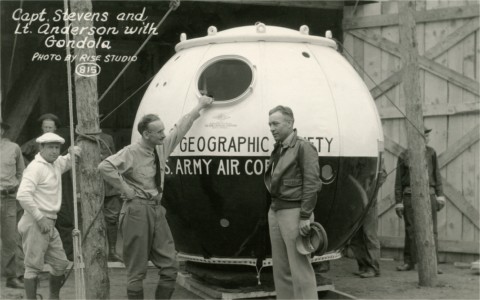
Just prior to ground contact, the Aeronauts called to spectators who were motoring to Explorer II, to catch hold of the drag rope which would have stopped the balloon. However, whether it was the ability to miscommunication with the people or the enormous size of the balloon, this never happened. Instead, ballast was thrown out in small quantities when a clear field was spied. After donning football helmets loaned by the Rapid City School, the balloon settled to the ground at 10 MPH, and the ripcord was pulled by both Aeronauts. This allowed the envelope to open instantly at the top and deflate quickly. The gondola turned onto its side and the Aeronauts, who were holding on the interior safety rope, were swung to the center of the gondola while instruments hurtled throughout the cabin. The cabin was in such a disarray, the Aeronauts could not exit without standing on instruments littered about. Except for the opening in the top of the balloon, no harm came to Explorer II as it lay where it landed in White Lake, South Dakota.
Instruments onboard
Explorer II
And why they were important
Samples of the air during the highest elevation (72,339). Each of the two samples consisted of nearly 6 gallons which equates to 1/15th of an atmosphere of pressure. And, when brought back to earth, it amounts to less than 1 quart under normal pressure. September 25-26, 2010 will mark the 75th Anniversary of the Explorer II. A small group of hot air balloon pilots, original members, and relations to original family members who were involved and who viewed history in the making will participate in an inaugural flight from the base of the Stratobowl.
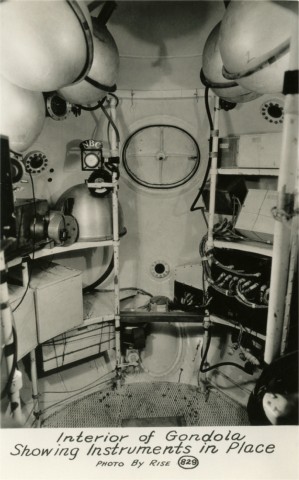
G.N. Shepherd of the National Bureau of Standards conducted the analysis of these two air samples. What was found? The composition of the stratosphere air is almost the same as that at ground level.
Cosmic Ray Apparatus furnished by Bartel Research Foundation of The Franklin Institute. This equipment registered the number and direction of the cosmic rays. This equipment also proved the intense radiation which is normally 30 cosmic rays per second at ground level, increased steadily to 55 times stronger at 57,000' and then back down to 42 times stronger radiation at 72,000 feet. This information would help pave the way for space exploration.
Two spectrographs designed and built by the Bausch & Lomb Optical Company and fitted with cameras made by the Folmer Graflex Corporation were utilized (one on the outside of the gondola and one on the inside).
The study of the amount of ozone by Professor Regener, proved the ozone layer exists at lower elevations than was once suspected (37,000 where the temperature reached -57 degrees Celsius). At the 72,000 foot level, 20% of the total ozone lay beneath the balloon. The ultra-sensitive film, especially coated by the Eastman Kodak Research Laboratory, proved the atmosphere holds back cosmic rays, as well as a certain amount of sunlight. The shorter waves of sunlight are responsible for the formation of ozone in the atmosphere. Dr. Brian O'Brien, Dr. F.L. Mohler, the University of Rochester and the Bureau of Standards conducted the testing from the spectrographs. Albert Stevens said, "...the balance of the ozone in our atmosphere has a tremendous influence on life as we know it. It ozone were rare, we would be sunburned by a few minutes exposure of sun. If ozone were more, then we would probably die for lack of essential vitamins...there would be an enormous increase in bacterial growth...fatal to human life."
An apparatus made by the Department of Terrestrial Magnetism of the Carnegie Institution of Washington, D.C. measured the change in the electrical conductivity of air. Ionization grows greater as one rises to a region of greater cosmic radiation. The more the air is ionized, the more easily it conducts electricity. Dr. O.H. Gish and K. Sherman examined the test results which proved the conductivity of the air at 61,000 feet was 81 times that of sea level and at 72,000 feet was 50 times more.
An 8 watt transmitting apparatus from the National Broadcasting Company at Rapid City allowed the aeronauts to be heard around the world. The outgoing signal frequency was 13,050 kilocycles while the incoming frequency was a little over 6,000 kilocycles. The incoming signals were received from a 200 watt transmitter.

The aeronauts talked to the giant Pan American Airway's China Clipper (an airplane which flew that same date into history by making the first transpacific airmail flight from San Francisco to Honolulu, Midway Island, Wake Island, Guam, Manila, and The Philippines) and Captain Edwin C. Musick and William Burke Miller (a Pulitzer Prize winning newspaper and radio reporter). Miller arranged for the aeronauts to talk to a newspaper in London, England.
Color photographs were taken with a National Graflex Camera loaded with DuFay color film. The color photographs, when developed, showed the sky was darker than the dark blue field of a large flag of the United States.